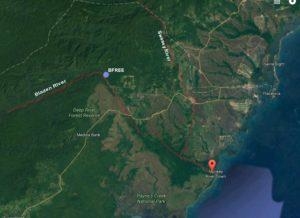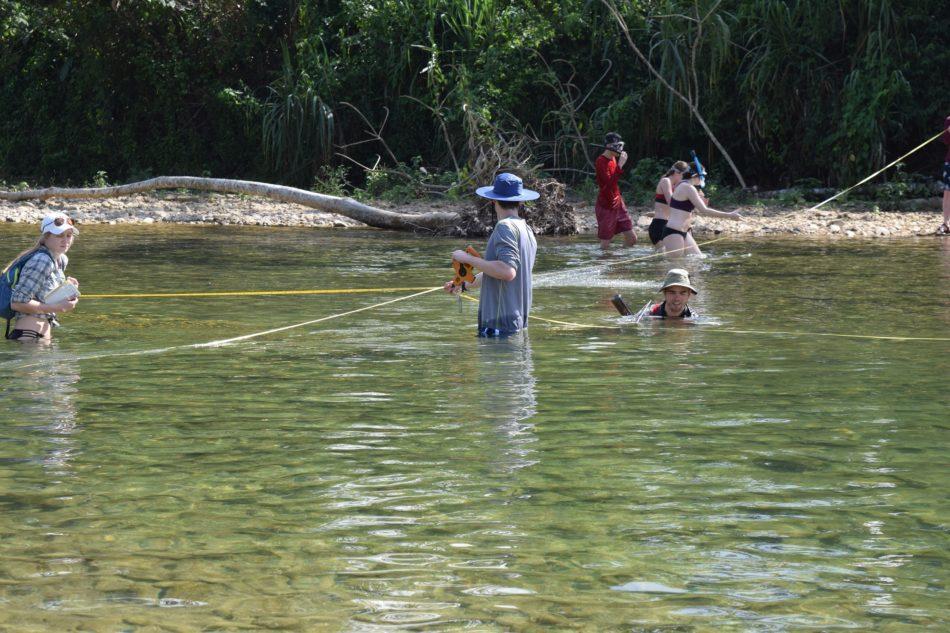A field activity for student groups studying the Bladen River at BFREE and beyond
Author, Amy Treonis, Department of Biology, University of Richmond, Richmond, VA

Map of Monkey River Watershed, showing potential study sites
Introduction: The Bladen River is one of the most spectacular features of the BFREE field station, offering countless opportunities for ecological research. The Upper Bladen watershed flows through the tropical broadleaf forest of the Bladen Nature Reserve, arriving at BFREE in a remarkably pristine state. From there, the river flows downstream into the Monkey River and ultimately empties into the Caribbean Sea at Monkey River Town. The river flows through a landscape that is a mosaic of protected and agricultural lands, including cattle pastures, banana plantations and subsistence farms (i.e., milpa). Replacement of riparian vegetation with agriculture has destabilized soils in many places, resulting in increased erosion and sedimentation throughout the watershed. Ultimately, this impacts both wildlife and people that depend on the river’s health. The river’s course has also been affected by natural events, such as Hurricane Earl in 2016.
Monitoring the physical, chemical and biological properties of rivers is an important strategy for environmental protection. The US EPA performs a National Rivers and Streams Assessment (NRSA) in order to determine the condition of the nation’s waterways and to monitor for changes over time. This assessment encompasses many groups of indicator variables, almost any which could be incorporated into a course-based study of the Bladen River or, more broadly, rivers or streams in the Monkey River watershed. The course activities outlined here focus on aspects of the river that could be affected by increased sedimentation. However, a river survey activity can be easily modified depending on the course focus, time available, and instructor expertise. For example, benthic macroinvertebrate kick net sampling is not described here but could be incorporated. The NRSA Field Operations Manuals are useful for ideas about modifying this activity.
Principal Ecological Question Addressed: How do the physical, chemical and biological characteristics of a tropical river change across its course, as it experiences natural and anthropogenic influences?

Students from University of Richmond implement river study field methods in the Bladen River
Student Outcomes: Upon completion of this experiment, students should:
- 1. Be able to identify the characteristics of a pristine river or stream.
- 2. Analyze and visually present data for comparison of stream locations.
- 3. Articulate the threats to the Monkey River watershed.
- 4. Connect anthropogenic activities to specific characteristics of surface waters in the Monkey River watershed.
Required Class Time: Each reach surveyed using the suggested protocol requires 60-90 minutes of time (excluding travel time in between reaches). Additional class time is required for data processing and interpretation.
Documents Provided:
River Survey Full Project Description
Literature Consulted and Additional Resources (see http://library.bfreebz.org for many of these):
Buck DG, Esselman PC, Villafranco J. 2011. Monitoring land use changes along riparian corridors in lowland tropical watersheds: Application of human impact mapping and estimation of local stress intensity. Mesoamericana 15: 51-62.
Clapcot J et al. 2011. Sediment Assessment Methods: Protocols and guidelines for assessing the effects of deposited fine sediment on in-stream values. New Zealand, Cawthron Institute.
Esselman PC. 2001. The Monkey River baseline study: Basic and applied research for monitoring and assessment in Southern Belize. Master of Science Thesis. University of Georgia.
Esselman PC, Buck DG. Hydrologic Assessment of the Monkey River Watershed, Belize.
Esselman PC, Freeman MC, Pringle CM. 2006. Fish assemblage variation between geologically defined regions and across a longitudinal gradient in the Monkey River Basin, Belize. Journal of the North American Benthological Society 25:142–156.
FishBase: http://www.fishbase.org/search.php
Greenfield DW, Thomerson JE. 1997. Fishes of the Continental Waters of Belize. University of Florida Press.




Leave a Reply
Want to join the discussion?Feel free to contribute!